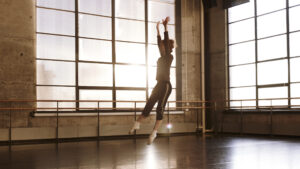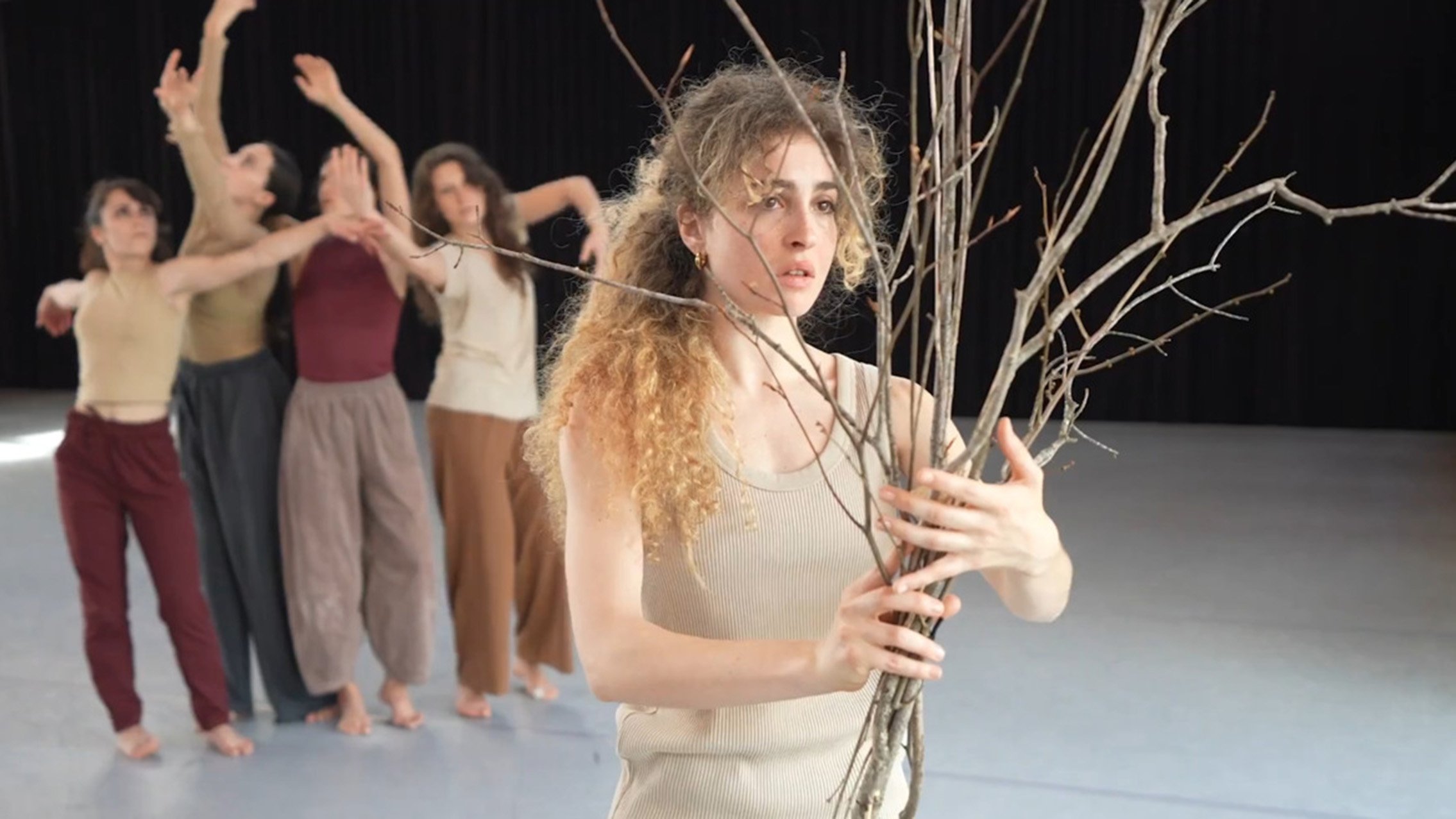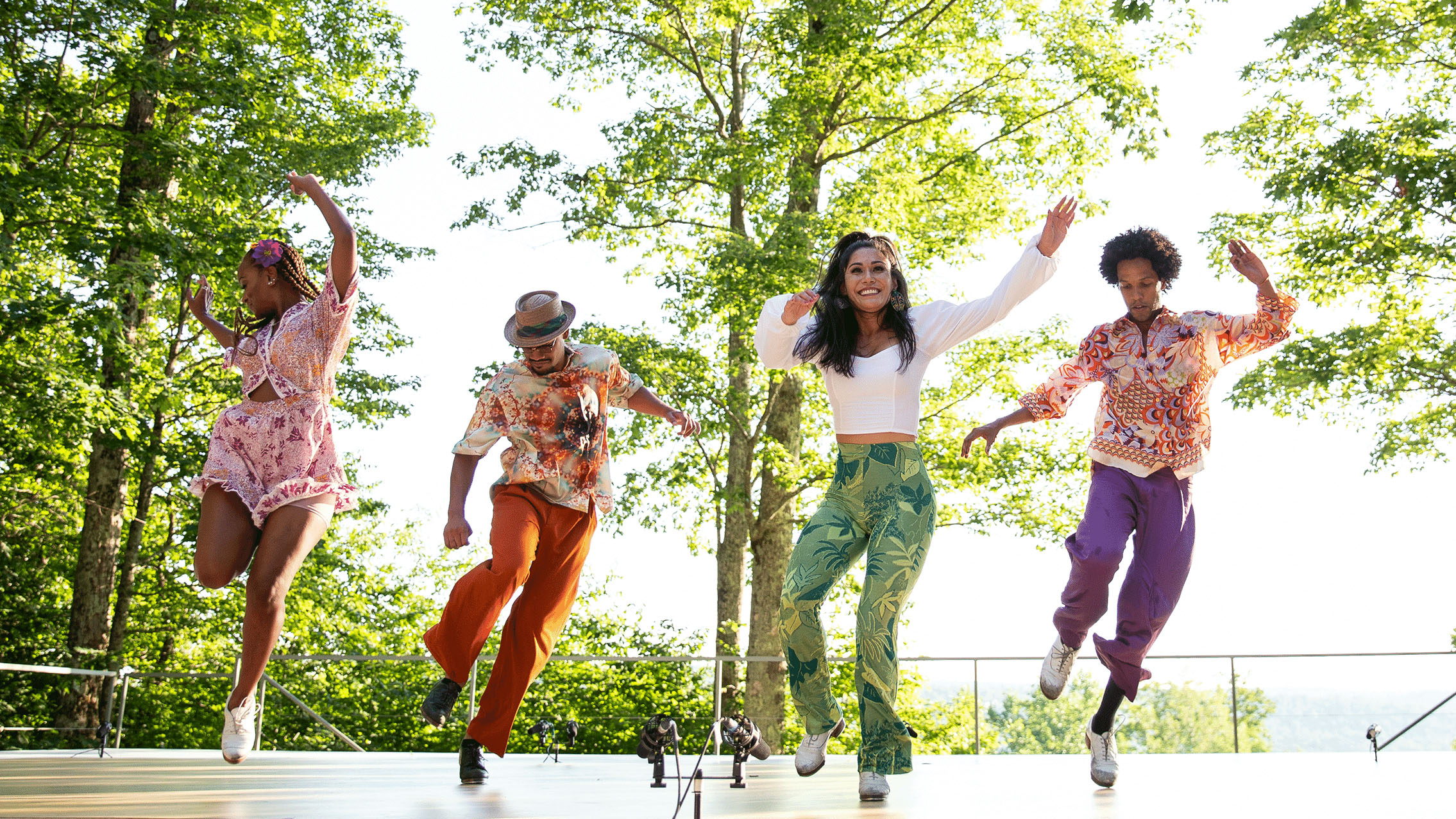
In the second Pillow Lab of the 2024-2025 season (and first and only Research Residency), from October 18-27, dancer-choreographer Emily Coates returns to Jacob’s Pillow to research and develop a new project that reflects on the enduring influence of George Balanchine in unexpected places, drawing from archives, special collections, and the bodies of dancers who worked with him. Read more about the artist below to discover her current inspirations, background, and what makes her residency unique.
What’s inspiring you right now?
I fell down a rabbit hole through Beyoncé’s excellent new album Cowboy Carter and got to know the music of Shaboozey, and through him Noah Cyrus. Speaking as a Gen X dance artist who stays far away from pop culture, I’m rooting for them. Both come across as older souls in younger bodies. I admire the depth of their search, within inherited musical genres, to find their own originality. I relate. Their singing, my dancing: you must lean into what you indisputably own to transcend all that history and make a mark as a creator in performance.
Listening to Shaboozey and Noah Cyrus while developing my current project made me realize that George Balanchine was basically a country singer. No whiskey, and via pre-revolutionary Russia, but tapping into the same infinite well of broken-hearted, unrequited love.
What can audiences expect from your time in the Pillow Lab?
I’m developing a new performance project that draws on traces of Balanchine scattered in archives across New England: archives as in things housed in libraries, and archives as in the bodies of dancers who worked with him. I’m looking for voices and poetics on the margins, which have been overshadowed or lost. Passion is a must for this kind of digging in the dust.
I started my career with New York City Ballet and then went off to have many other great experiences, with Baryshnikov, Twyla Tharp, Yvonne Rainer, and making my own work. With this project, I’m returning to my roots. Coming on the heels of NYCB’s 75th anniversary, it’s a way to pay homage but also expand the possibilities for new work influenced by that heritage.
I’ll have a team of artists with me at the Pillow who are as enthralled with archives as I am. I’m the choreographer and writer, also performing; Ain Gordon is director and dramaturg; Derek Lucci is an actor who is also contributing to the research; and Charlie Burnham is a violinist and composer. Much of our time will be spent in the studio, building the performance. You may hear the strains of Charlie’s evocative and legendary violin; he will be composing a new composition drawing on musical scores written by Balanchine.
Is there a piece of advice or wisdom that has stuck with you as an artist?
The artists who have reminded me over the years: “Remember, you’re a dancer.” (Thank you, Misha, Twyla, Trisha, Ain.) I’ve done a lot in my career and have at times moved far away from dance. Having their reminder echoing in my head has brought me back to my art form, in moments when I have felt lost.
What’s one challenge you’re excited to tackle in your current project?
I’ve been teaching Derek, an actor, some basic principles of Balanchine’s style. In exchange he has promised to teach me how to deliver a dramatic monologue!
How has your cultural background or heritage influenced your work?
I grew up in Pittsburgh and partly in Brussels, Belgium, where I took my first dance class. When we moved back to the US my mother enrolled me at École de Ballet, a storefront studio run by two local Pittsburgh women who had never danced professionally. They licensed their syllabus from the Royal Academy of Dance in London. I received solid, unmannered training at a young age from them. Allegra Kent tells of one of her first teachers, Bronislava Nijinska, in LA. My first ballet teachers were working class custodians of culture – see my interest above in voices on the margins.
What’s one thing you always have with you in the studio?
A notebook and pen! I tend to write in the studio as a way of solving choreographic problems and opening up my ideas. The two practices are deeply intertwined for me. I get restless in the studio alone. If I write a bit I find my grounding. That’s when the process is entirely on my own terms. When I’m choreographing for a work of theater, or with music guiding, I jump-start in other ways.
What do you hope to take away from your time at Jacob’s Pillow?
I love hanging out with the artists I’m working with on this project – I think that’s important. We laugh a lot and try to solve life, or not. This is the second project with this team and I’m excited to be developing a shared language. It began with a dialogue I struck up with Ain several years ago, when I was wrestling with very personal questions about meaning and art-making. Ain has received many accolades for his own work – someone needs to create an award for generosity toward other artists and make him the first recipient. This project is one extension of that conversation.
I have also become very interested in local/regional histories and finding ways to shift the center away from New York-centric dance histories to the many other intricate networks that exist on the margins. Making this work in residence at the Pillow and elsewhere outside of New York City and connecting with other dancers in the outer orbit who like me carry the dust of this major twentieth century choreographer feels important. I created the curricular dance program at Yale and have lived in New Haven for a decade now. Derek is a former NYC-based actor who grew up in New Hampshire, where he has founded a project called Open Sky, to impart the skills of advanced actor training for incarcerated persons, to empower them to successfully reintegrate into society. Just two examples of the ways knowledge gets redistributed regionally.
New England as a region is arbitrarily prescribed, of course: it’s seized and occupied, renamed, remapped to form this American project we inhabit. I sometimes feel I need to trace all the way back into geological time and tell the story of how our planet formed, from which emerged the conditions that allow for humans, artists, and dance—to fully tell the story. But that performance would be endless.
Can you describe your artistic journey in three words?
Restless, questioning, devoted.
Is there something you’re currently reading, watching, or listening to that’s influencing your work?
In the past year I discovered the work of poet Susan Howe, who lives near me in Connecticut and has become a friend. My Emily Dickinson, The Birth-mark, and That This are just three of many books of hers that have taught me to see the possibilities for creating new poetics from archives. I’ve also been re-reading an essay by my friend Brent Hayes Edwards, “The Taste of the Archive,” which brilliantly sums up the problems and the potential of archives. I’m also completely inspired by my daughter, Eula, who sings, dances, reads, writes stories, and does many, many handstands in a day.
What’s next for you after your residency at the Pillow Lab?
This project is commissioned by Works & Process at the Guggenheim. I have a Works & Process LaunchPAD residency at The Church at Sag Harbor in early January. We’ll then present an in-progress version of this piece at the Guggenheim Museum on January 12, 2025 through their 2025 Works & Process Underground Uptown Dance Festival. The project will continue to be supported with a Works & Process LaunchPAD residency at the Catskill Mountain Foundation. We’ll return to the Quick Center for the Arts at Fairfield University in March. The work will premiere in 2025-2026. Come find us at any one of these venues and more!
Emily Coates (writer, dancer, choreographer) has performed internationally with New York City Ballet, Mikhail Baryshnikov’s White Oak Dance Project, Twyla Tharp and Yvonne Rainer. Highlights include three duets with Baryshnikov, in works by Erick Hawkins, Mark Morris, and Karole Armitage; principal roles in works by George Balanchine and Jerome Robbins; and Rainer’s work from 1961 to the present. Her choreographic projects have been commissioned and presented by the Baryshnikov Arts Center, Works & Process at the Guggenheim, Wadsworth Atheneum, Quick Center for the Arts, Hopkins Center for the Arts, University of Chicago, Danspace Project (NYT Critic’s Pick 2017, NYT Fall Dance to Watch 2018), Performa (NYT Best Dance 2019, with Yvonne Rainer). Most recently she was a featured artist in the performance exhibition Hard Return at the Neuberger Museum. She has received support and fellowships from the Alfred P. Sloan Foundation, Center for Ballet and the Arts, Jerome Robbins Dance Division/New York Public Library for the Performing Arts, New England Foundation for the Arts, and National Endowment for the Arts. She is professor in the practice and director of dance studies at Yale University, where she created the dance curriculum. She co-authored Physics and Dance with physicist Sarah Demers (2019), and co-edited Remembering a Dance: Parts of Some Sextets, 1965/2019 with Yvonne Rainer (2023). emilycoates.art
This Pillow Pick was written by Bonnie Spann and published on October 10, 2024.

Inside the Pillow Lab is an intimate film series that captures works in process and behind-the-scenes moments of what it’s like for artists to live, work, and rehearse together in residencies on the Pillow’s retreat-like campus.

A year-round incubator of new work, the Pillow Lab hosts ten artist residencies this fall, winter, and spring. Learn more about the dance artists who will be joining the Pillow during crucial development, research, and technical stages of choreography-driven projects.